
views
Important Features of Prescription Safety Glasses

ANSI-approval The American National Standards Institute (ANSI) ensures that all safety glasses have passed or exceeded safety standards. ANSI-approved glasses are impact-resilient (they won’t shatter when hit by flying particles), can block non-ionizing radiation, and can protect against liquid splashes. ANSI-approved glasses are the standard for jobs like machinery operations, material welding and cutting, chemical handling, assembly operations, woodworking, electrical work, and medical or lab research. How can you tell if glasses are ANSI-approved? Look for a marking like “Z87,” “Z87.1,” or “Z87+” on the glasses, usually located on the temples. A reputable safety glasses retailer like RX Safety will only carry ANSI-approved products. What does OSHA say about prescription safety glasses? According to the Occupational Safety and Health Administration (OSHA), “OSHA requires that eye protection must comply with either of two consensus standards incorporated by reference in OSHA's eye protection standard at §1910.133(b). These are Occupational and Educational Personal Eye and Face Protection Devices, ANSI Z87.1-.1989 and ANSI Z87.1-2003.”
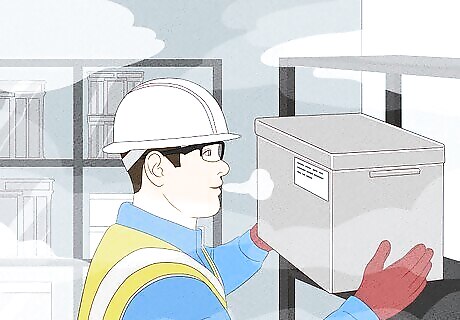
Protective lens coatings While prescription safety lenses are durable against high impacts, most manufacturers also offer additional coatings for extra protection. These add-ons may increase the price but can extend the life of your glasses and keep your vision clear in dangerous situations. Optional (but recommended) coatings include: Anti-fog: This prevents fog from obscuring your vision in hot and humid or cold climates. Anti-scratch: This helps protect the lenses from scratches that can affect your vision and shorten the life of your lenses. Anti-UV: This coating blocks UV rays from entering clear lenses as well as sunglasses do. Plastic lenses require an anti-UV ray coating, while polycarbonate lenses block UV on their own. RX Safety’s high index and polycarbonate lenses have UV protection built in! They also offer additional anti-fog and anti-scratch protection for maximum clarity and visibility.
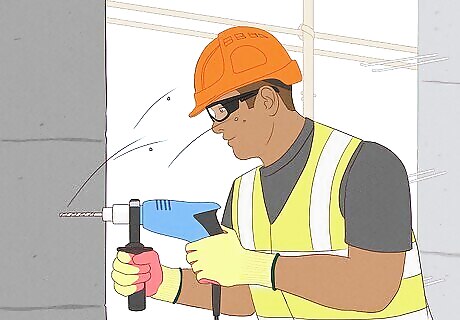
Side shields Side shields are attached to the arms of your glasses and offer additional protection from flying materials or splashes from the sides. RX Safety has a variety of frame styles with either permanent or detachable side shields, depending on your work needs and aesthetic preferences. The type of work you do or your workplace requirements may determine if side shields are required to meet safety regulations. Do you need side shields? According to OSHA, side shields are required when flying objects are a hazard: “The employer shall ensure that each affected employee uses eye protection that provides side protection when there is a hazard from flying objects. Detachable side protectors (e.g., clip-on or slide-on side shields) meeting the pertinent requirements of this section are acceptable.”

Affordability Thankfully, many pairs of ANSI-approved prescription safety glasses start at under $60. However, it’s always worth it to pay a few extra dollars to protect your eyes and vision (particularly if you work in a field like construction or machine operation). Add-ons like protective coatings or detachable side shields (if your pair doesn’t come with them) may increase the price of your safety glasses. Do employers pay for prescription safety glasses? According to OSHA, safety glasses should be covered by employers if they're used to meet OSHA requirements. However, prescription safety glasses may be exempt due to their personal nature and ability to be worn off-site. Speak with your employer to see if they may be covered in your case. Concerned about the cost of safety glasses? RX Safety offers a wide range of styles to choose from, with some starting as low as $20! No matter how affordable, each pair is ANSI-approved and designed to protect your eyes from impacts whether you’re gardening or welding.
Ordering Prescription Safety Glasses Online

Get an eyeglass prescription. If you don’t have your glasses prescription on hand, contact your eye care provider and request a copy (you’ll need to upload this info when you order your glasses). If it’s been over a year since your last prescription, you may need to schedule an appointment to get a new one. Contact your provider and explain that you need an exam and glasses prescription to get safety glasses. In most US states, eyeglass prescriptions are valid for either 1 or 2 years. In North Dakota, they’re valid for 3 years and in Florida, they’re valid for 5.
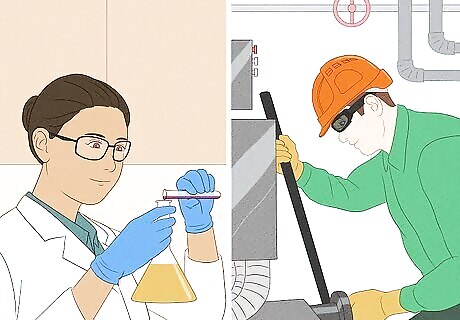
Choose your frames. Now for the fun part! Browse different frame styles and colors to see which pair of safety glasses reflects your look. Consider your environment—a pair resembling eyeglasses may work best in a lab or hospital environment, while a heavy-duty goggle frame may be best for industrial settings. Just make sure the frames you choose are ANSI-approved for maximum protection. If you work with electricity, avoid metal frames as these can potentially conduct electricity. Need some inspiration? RX Safety has stylish safety glasses for both men and women to complement any look. Browse their collection of glasses, goggles, wraparounds, semi-rimless frames, fit-overs, and more to find the perfect pair for you and your work.
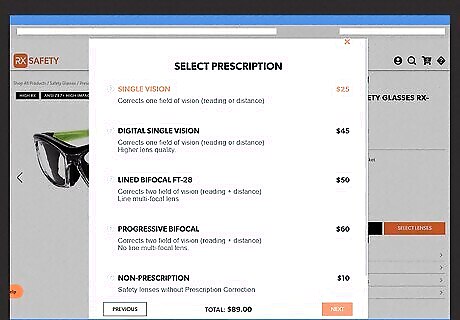
Choose your lenses. Depending on the manufacturer, you may get to choose several lens features such as: Lens type: Most companies offer single-vision, bifocal, and progressive lenses. Lens material: Choose from trivex (light and durable lens material), polycarbonate, high index (for strong prescription), or traditional glass lenses. Lens coatings: These include options for anti-fog, anti-scratch, anti-UV, and anti-glare applications. Lens polarization or tint: Often, you can pick whether your lenses are clear, polarized, or tinted in a specialty color like yellow or orange.
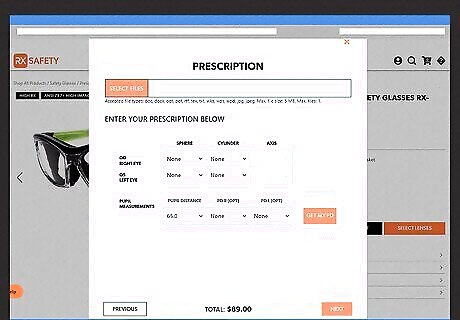
Enter your prescription and order your glasses online. Add your glasses to your cart and follow the prompts to enter your customizations, prescription information, and payment and shipping information. Through RX Safety, you can upload a digital copy of your prescription or enter it by hand. Once all your information is entered, you’re ready to check out! Tip: Check with your vision insurance provider to see if prescription safety glasses are covered under your plan and how to file a claim if so.

Check the fit when they arrive. Try your glasses on and see how they feel. If they’re too loose or too tight, contact the manufacturer’s customer service department and ask about your resizing options. If they fit well but feel uncomfortable, you may need nose pads, retainer cords, spring hinges, or other customizations to achieve the perfect fit. How long does it take to get prescription safety glasses? It depends on the manufacturer and the complexity of your order. At RX Safety, prescription orders are typically produced and shipped within just 7-10 days! Non-prescription safety glasses have a faster turnaround time, while specialty frames or lenses for strong prescriptions may take longer.
Cleaning Prescription Safety Glasses
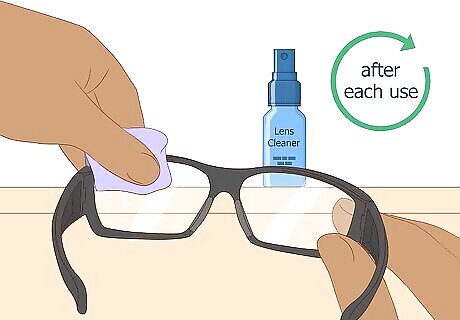
Daily cleaning After each use, inspect your lenses for smudges or spots and gently rub them away with a microfiber cleaning cloth. To remove dirt and debris and to disinfect your lenses, spray them with a lens-cleaning solution and wipe dry with a clean microfiber cloth. When you’re not wearing your glasses, store them in a protective case. A hard or semi-hard case with a soft lining is perfect for protecting the lenses and frames from knocks and falls.
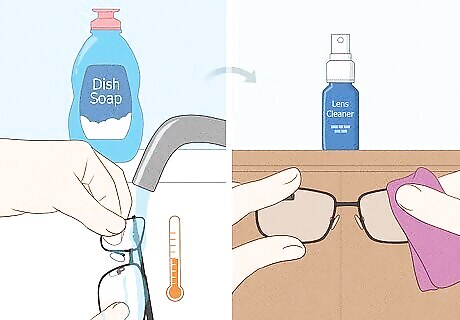
Deep cleaning Rinse the glasses under lukewarm water to wash away loose particles and debris. Apply a drop or 2 of dish soap to the lenses or your fingertips, then gently wash the frames and lenses with your hands. Rinse off the glasses and pat dry with a microfiber cloth. Use your lens-cleaning spray to remove any watermarks or soap residue. Do not use paper towels or even your shirt to dry your glasses, as these rough textures can make tiny scratches on your lenses. Only use dish soap or a lens-cleaning solution on your safety glasses. Avoid harsh products like glass cleaner or ammonia.
FAQs: Prescription Safety Glasses
What do prescription safety glasses do? Prescription safety glasses or goggles allow people who normally wear prescription glasses to see clearly while working in hazardous environments or with hazardous materials. They protect the eyes from the front and sides from flying particles and debris, chemical splashes, and non-ionizing radiation. Safety glasses are designed for work environments and may not be suitable for sports and athletics. Safety glasses are not designed to protect from bloodborne pathogens, X-rays, high-energy particulate radiation, microwaves, radio-frequency radiation, lasers, or masers.
Do prescription safety glasses come as sunglasses? Yes. Most manufacturers offer UV-resistant lenses (like sunglasses) that can be either clear or polarized. Some also offer a choice in lens color or tinting, like yellow or orange lenses, as well as transition lenses for indoor and outdoor use.
Can safety glasses accommodate any prescription? Standard safety glasses can accommodate most prescriptions, but very strong prescriptions may require specialty frames or lenses for the best visibility and protection. If you have a strong prescription, consider buying fit-over safety glasses designed to fit over your normal pair. Fit-overs are usually larger than normal safety glasses and may look like goggles.
What are prescription safety glasses lenses made of? Most protective lenses are made of polycarbonate. This material is considerably stronger than traditional plastic or glass lenses and can withstand impacts that would shatter your everyday glasses. These lenses are typically more expensive than plastic or glass.
What are prescription safety glasses frames made of? The frames are typically made of either metal, nylon, acetate, or TR-90 thermoplastic. Each material is Z87+ certified and safe to wear in hazardous environments. Metal frames may be heavy and slightly uncomfortable, but they’re incredibly durable. However, they’re not a good choice for electricians as they can conduct electricity. Nylon is lightweight, flexible, impact-resistant, and hypoallergenic. Acetate is durable and versatile. It offers the most variety for style and customized fit. TR-90 plastic is lightweight, flexible, durable, and UV-resistant, making it great for outdoor work.
Can you get multi-focal or progressive lenses? Yes. Most manufacturers offer lined bifocal, progressive no-line bifocal, and progressive bifocal prescription lenses. Individual manufacturers may have slightly different offerings, so compare lenses from several brands to find the right ones for you.
Are prescription glasses ok as safety glasses? No. Regular prescription glasses are made of less durable frames and lenses, meaning they offer less protection in hazardous environments. Normal glasses also lack side shields, leaving the side of your eye vulnerable to impacts and splashes.


















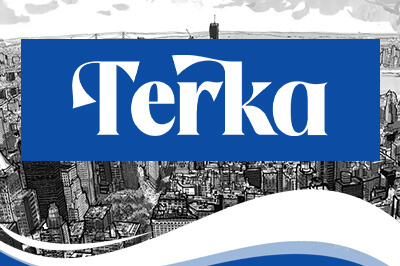
Comments
0 comment